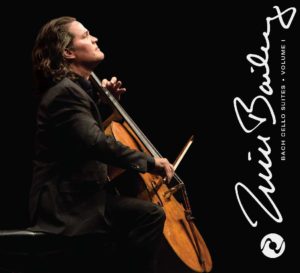
Zuill Bailey. Bach Cello Suites. Octave Records 2021. Catalogue no. 0008. Recorded, Mixed and Mastered using Five/Four REVEAL SDM DSD Technology.
Available as high-resolution download PCM and DSD files, various bit rates and as SACD hybrid and DVD.
Recorded at Ikeda Theater, Mesa Arts Center, Mesa Arizona, January 23-27, 2021.
Cello used. 1693 Mateo Goffriller Ex Mischa Schneider “Rosette” cello – Venice, Italy.
Copious other detail regards equipment used and technical matters in accompanying notes.
Introduction.
This is a real feast for audiophiles, especially those who have moved on to High Resolution downloads. These are enthusiasts who include state of the art streamers and digital to analogue converters capable of dealing with both PCM and DSD files within their systems.
Spurred on by the availability of this recording by an artist I respect hugely, I have invested in the budget Topping E30 DAC, (£150) connected to my Apple Mac via USB and fed by Audirvana software (£66 annually). I have to say the results are very satisfactory! Downloads and physical discs are available from the PSAudio website directly and also a number of hi fi retailers.
https://www.psaudio.com/products/bach-cello-suites/
The cost varies dependant on the format purchased but is at least £55.
The Recording.
So from an audio quality perspective, was my investment worth it? The answer is a definite yes. Considering that I am comparing the sound obtained from the above software and DAC, with a Naim CD5XS and Flat cap XS power supply, then I feel it is safe to suggest this recording will clearly be capable of delivering spectacular results with the top end equipment. This equipment, one can buy for many thousands of pounds from manufacturers such as PSAudio. I should hasten to add that because there is no Red book disc release of this recording I cannot make a direct comparison. I am drawing the comparison with other CD recordings of the Suites, such as Bailey’s own first release on Telarc discs from 2010. Whether the additional investment is worth the level of improvement is a personal choice.
As most readers will realise simply having more bits and higher sample rates is not sufficient. The quality of components and power supplies together with overall design make a huge difference to sound quality. My budget high resolution set up lacked a certain amount of weight and attack.
What I could appreciate even on my budget set up was that there was a very wide sound stage, impressive depth and amazing detail of tone from the instrument. Dynamics were delivered brutally clear in some instances. It was the smoothness of the cello tone in all registers that I enjoyed most particularly with DSD. I do think that cello recordings are very revealing of the limits of Red Book with coarseness and rasping even in the best performances being noticeable. The only downside with this detailed delivery was the clearly audible breathing, and other artist murmurs.
The cellist.
My review of the artist’s first recording can be read here:
https://bachcellosuites.co.uk/bach-cello-suites-home/list-of-reviews/zuill-bailey/
Since the time of writing we have of course had the Covid pandemic with world wide lock downs. This naturally has affected Bailey as it has many other performers whose careers have in effect been put on hold. The accompanying notes give some insight at quite a personal level as to how this has affected him.
The thirteen years between recordings of the Suites have been filled with an otherwise growing international career. In complete contrast to the Bach, I found a live recording of the Elgar cello concerto which I recommend as being outstanding, both technically and musically.
The music.
It has to be said that the style of playing on this recording is not hugely different when compared to the first recording. I found Bailey’s first recording had wonderful variation of dynamics, mood and different tonalities. Allemandes and Sarabandes being very gentle and almost sweet in nature. In contrast the Preludes, Gigues and fifth dance movements were often assertive even aggressive as well as rhythmic. Much of this is carried on with this latest recording perhaps even more marked.
I note a similar change in the two recordings made by Paul Tortelier. His second recording is almost theatrical with exaggerated contrasts and style. I would suggest Bailey takes a similar route. Sometimes it works but at other times it causes me to worry. None more so than in the fifth Sarabande. The simplicity of this piece seems to get lost with variations in speed, dynamics and phrasing. To me this is a place for “less is more.”
Another concern that struck me was that there did seem to be some inconsistencies of intonation creep in from time to time. Listen to the two Bourees of the third Suite. I thought the second dance in a minor key seems sharp at times. The Bouree of the fourth Suite appears to lose precision of the semiquavers in places. I think my expectations were rather high based on the excellence of the first recording and there is some suggestion in promotional video that the recording was at least in part “live”
Conclusion.
In summary a very exciting release, pushing the boundaries of the recording techniques currently available. If you enjoy the Suites and take pride in your equipment, then this is certainly a demonstration recording to test your set up.
I would describe the music and interpretation as being like a very slightly over -ripe fruit. Full of flavours but ever so slightly soft in places lacking the ultimate levels of precision, accuracy and coherence that mark out a truly distinctive recording.
Charles.